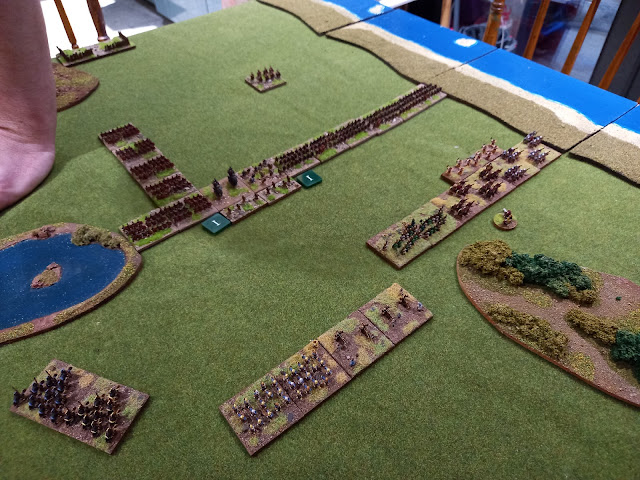This week Lee cross the Foyle to lead a Spartan expeditionary force against my Macedonians for a game of Fantastic Battles. Both armies included priests to read the omens (magic-users with level 3 prophesy). As the sun rose over the plain, a heron was sighted flying east with a frog in its beak. The frog escaped, fell to earth, but then hopped away. Clearly the gods meant the message to be understood as a disastrous omen. But for which side?

My Macedonian defenders (lower part of the photo, from left to right) consisted of two small units of elite Macedonian hetairoi (one diseased), backed up by a unit of tribal levy/dross, and accompanied by the king and a strategos. To their right was a second unit of tribal dross, but these lads were overly enthusiastic and deployed too far ahead of the main force (and their commanders). In the centre were the Macedonian hoplites led by another strategos and screened by Macedonian archers, an equal number of diseased Thesslian hoplites lead by a priest and screened by mixed slingers and archers, Thessalian heavy cavalry and some (late) Thessalian peltasts, led by a Thessalian strategos. The Macedonians took the 'Master of the Horse' strategy meaning that their mounted units gained an additional attack dice when they charged.

The Spartans drove their cattle forward, hoping to disrupt the Macedonian tribal levies. However, before they came close, the Macedonina hetairoi thundered forward and dispersed them with little hesitation. Unfortunately for the flower of Macedonian nobility, the charge brought them within range of the Spartan slingers and their auxiliary light horse who both rained down (pretty devastating) missile fire.
In the next turn, the light cavalry and skirmishers both turned in on the hetairoi and charged into their target's flanks. The Spartan's allied cavalry were, in-turn, charged in their own exposed right flank by the second unit of Macednian cavalry. Over on the Macedonian right, the Thessalian peltasts engaged with the Spartan peltasts in the woods.
With the Macedonian cavalry fully engaged, the Spartan allied hoplites had no room to manoeuvre into combat. However, one of the large tribal units of Macedonian levy threw themselves forward into the exposed flanks of the Spartan skirmishers.
The Spartan archers ran forward to attack their Macedonian counterparts in melee while the Spartan hoplites set off to hunt the Thessalian cavalry who were avoiding the woods in a very studied manner. They promptly turned around, hoping to lure the Spartans in their wake.
The large melee on the Macedonian left, the Macedonian hetairoi finally broke under pressure from the two flanking attacks, but as they scattered, their foes too fell before the attacks from the other Macedonian cavalry unit and the tribal levy. The melee between the opposing forces of peltasts in the woods at the far end of the battlefield was proving mutually destructive, with both units a mere 1 Resolve point away from scattering.
In the centre - with the obstructing melee cleared, Sparta's allied hoplites slammed into the tribal levy.
Seizing the initiative, the Spartiate hoplites also charged forward, straight into the rear of the Thessalian cavalry. The Spartiates needed to roll 5+ to inflict hits on the Thessalians. The cavalry needed to kick back and roll 6s.
The resulting combat was a little one-sided.
Behind the slaughter of Thessalian horses, the Spartan peltasts finally finished off the Thessalian peltasts in the woods and the second unit of Spartan peltasts charged the flanks of the Macedonian hoplites (before once again being charged in their own flank!).
Sparta's large unit of allied hoplites ploughed straight through the Macedonian levy with ease, but then found themselves outflanked. The remaining Macedonian tribal levy charged their right flank, the Macedonian hoplites, in column, attacked their left fank, while the last of the Macedonian cavalry had swept around and now bore down on their rear.
The last Thessalians standing - the three-company hoplite unit - squared off against the Spartiates and were able to hold their own.
It Looks like the frog had hopped for Macedon. In the end, the allied hoplites could not stand against the assault from three sides. Although they attempted to turn to face their enemies, it was too late to save them and the unit scattered. The Spartiates and a badly-blooded unit of peltasts still held firm, but as an expeditionary force it was over. The Spartans would need to withdraw and regroup leaving the Macedonians victorious; free to return to their mountains and their goats, and fighting among themselves.



















































